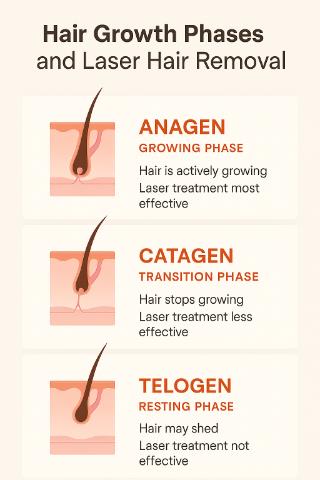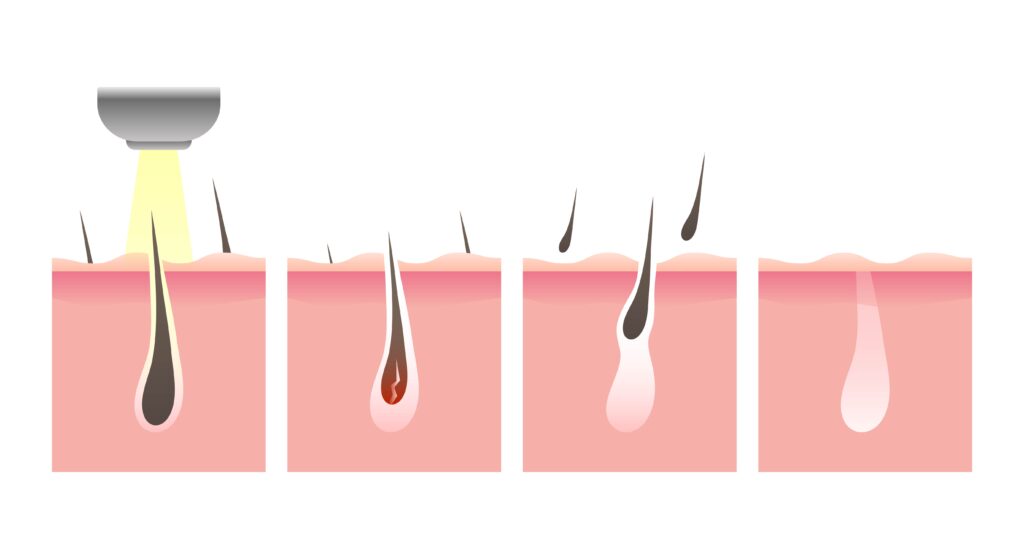Hair Growth Phases & Laser Hair Removal
Laser hair removal has become a cornerstone in aesthetic practices because of its efficiency, safety, and popularity with patients. However, success depends on more than just using advanced technology. A deep understanding of the laser hair removal hair growth cycle helps providers deliver consistent, effective outcomes and set realistic expectations for their patients.
Understanding Hair Growth Cycles
Our hair undergoes three main phases in its growth cycle, including:

- Anagen (Active Growth Phase) – The hair is actively growing, and the follicle is deeply embedded in the dermis, connected to a rich blood supply. Laser treatment is most effective during this phase because the pigment (melanin) in the hair shaft absorbs the laser energy, transmitting heat to the follicle and disabling it.
- Catagen (Transitional Phase) – The hair follicle begins to shrink, and the hair detaches from the blood supply. Laser treatment is less effective because the follicle is not actively growing.
- Telogen (Resting Phase) – The hair is dormant and eventually sheds, allowing a new anagen-phase of hair to take its place. Since the follicle is not producing pigment, laser energy has little effect.
Because hair is in different phases at any given time, multiple laser sessions are required to
effectively reduce hair growth.
Why Hair Growth Cycles Matter in Laser Hair Removal
Laser hair removal works by targeting the pigment in the hair follicle. The laser’s energy is absorbed by the pigment, heating the follicle and destroying its ability to produce hair. However, for this process to be most effective, the hair needs to be in the anagen phase.
During the anagen phase, the hair has the highest concentration of melanin (pigment), which makes it an ideal target for the laser. The connection between the hair and the follicle is strongest during this phase, ensuring that the laser’s energy is efficiently transferred to the follicle. Because only a percentage of hairs are in the anagen phase at any given time, multiple laser hair removal sessions are often required to catch more and more hairs in this optimal phase.

How Hair Growth Cycles Guide Treatment Intervals
If sessions are booked too close together, many hairs may still be in the telogen phase and won’t respond. If treatments are too far apart, new follicles may already have cycled out of the growth phase, reducing effectiveness. This is why most treatment plans recommend intervals of four to eight weeks, depending on the body area. By following this timing, patients see the benefits of laser treatment and hair regrowth as more follicles cycle into the growth stage and are permanently reduced with each session.
When Should Patients Book Their Next Session?
Timing plays a major role in the success of laser hair removal. Use this quiz to help determine when patients are most likely ready for their next appointment.
How many weeks has it been since the last session?
- Less than 4 weeks – This is too early. Most follicles are not yet in the anagen phase.
- 4–8 weeks – This is ideal timing. Many follicles are now in the active growth phase, making this the best window.
- More than 8 weeks – Some follicles may have already cycled out of anagen. It’s best to schedule soon to stay on track.
Is visible regrowth noticeable in the treated area?
- Yes – This is likely a sign that new hairs are in the anagen stage and can be effectively targeted.
- No – Waiting a little longer may help ensure more follicles are ready for treatment.
Is the patient following the recommended intervals for treatments?
- Yes – Encourage patients to continue following the recommended intervals.
- No – Kindly remind patients that results will be diminished by not following the recommended intervals.
Maximizing Laser Hair Removal Results
Patients can make the most of their laser hair removal treatment by:
- Getting consistent sessions – Adhering to a treatment schedule ensures that hairs are targeted as they enter the anagen phase.
- Avoiding sun exposure – Tanned or sunburned skin can be more sensitive to lasers. Plus, increased skin pigmentation can reduce the contrast between the hair and skin.
- Avoiding plucking or waxing – These methods remove the hair from the follicle. Laser hair removal needs the hair intact as a conduit for the laser’s energy.
Why Trust Signals Matter in Aesthetic Treatments
In an increasingly competitive aesthetics landscape, patients seek reassurance that they are choosing a provider who prioritizes safety, quality, and results. Demonstrating credibility through clear trust signals can help practices stand out and build long-term confidence. Practices should have:
- Commitment to standards – Visible certifications and adherence to industry regulations reflect a provider’s dedication to maintaining high levels of safety and care.
- Professional validation – Recognition or endorsements from medical experts serve as an additional layer of assurance, reinforcing that treatments and technologies are both reliable and effective.
- Investment in innovation – The use of advanced, carefully vetted technologies communicates that a practice is forward-thinking and committed to delivering the best possible outcomes.
FAQs About Hair Growth Cycle
Why is the hair growth cycle important?
The hair growth cycle determines how effective each treatment will be. Because hair grows in different phases, only a portion of follicles are active at any given time. Multiple sessions are necessary to target hairs as they move into the growth stage, ensuring better long-term reduction.
Why is the anagen phase the most effective for laser removal?
The anagen phase is when hair is actively growing and attached to the follicle. Anagen phase laser effectiveness is highest because the follicle still contains melanin that absorbs the laser’s energy. This allows the laser to disable the follicle and reduce regrowth over time.
What is the difference between telogen and anagen?
In the anagen phase, hair is actively growing and can be targeted by laser energy. In the telogen phase, hair is resting and detached from the follicle, making treatment ineffective. Understanding telogen versus anagen is critical for scheduling sessions at the right time.
How does laser hair removal timing affect results?
Proper laser hair removal timing ensures that more hairs are treated in their active growth phase. Appointments are usually spaced 4–8 weeks apart, depending on the body area, so that new follicles cycle into anagen and can be effectively targeted.

Learn More About Laser Hair Removal
Understanding the intricacies of the hair growth cycle offers valuable insights into why laser hair removal requires patience and persistence. With each session, you’re progressing towards smoother, hair-free skin. ZianMed gives dermatologists, physicians, laser professionals, and med-spas the tools and confidence they need to deliver excellent results for their patients. Contact us today if you want to expand your services with our state-of-the-art hair removal equipment.
